November ~ Goal Setting
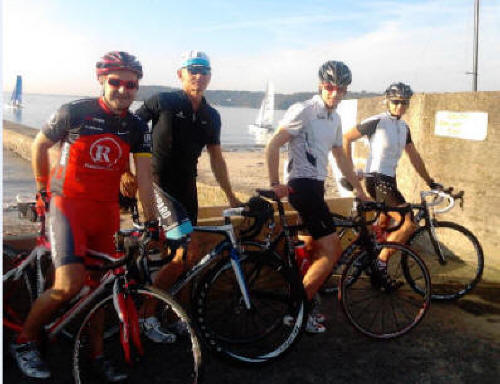
Gunsite Gregari ready for the off
on a gloriously sunny autumnal recovery morning
(l-r) Mick Heald, the late great Martin Baudains,
Chris Stephens, Andrew Perree
That's it, October has been and gone. Your month of rest is now behind you. Goes quicker than you'd like it to, doesn't it?
Success for next season starts right here and starts right now. But that doesn't mean you just go out and ride fast for a couple of months; hoping to get fit in or around an event you may or may not be doing next year.
If you want to compete seriously next season and realize your true potential, you need to start thinking seriously about your winter training and what your training for. Is it a TT PB, a century ride, an Etape, a classic sportive, or a local Crit championship?
If, however, your reason for riding a bike is to keep fit by riding around with friends and socialising, well that's as good a reason as any. So crack on. Not everyone wants to be a racer or has a competitive objective lined up. But if you're reading this website, you're probably one of the former. So let's explore your options.
Structure Your Approach
To compete seriously you need to plan seriously. But it
doesn't have to be boring, longwinded, arduous or, ironically, serious.
This is the bit that gives you the motivation to get in to that cold turbo shed, to go out when the rain's lashing down, or get suited and booted when it's a freezing January morning. This is the bit that can make or break your season.
It's also a good way of keeping yourself busy while the X-Factor or Strictly, is filling the airwaves and entertaining the masses.
Using our slightly modified, hardly original but surprisingly ignored, business strategy approach, we need to Think ~ Plan ~ Act our way to success. As we've said elsewhere, "Hope is not a Strategy".
Think about what you want from next season and draw up a shortlist of pre-defined goals. Lose weight, gain power, raise cadence, etc.
Next create an action (training) Plan. A structured, step by step route-map to help you month by month move closer to those prioritised goals. Don't just write a list and put it in a drawer.
Follow the plan and Train your body, through sustained adaptation and overload, to better prepare for meeting the requirements of your pre-defined goal.
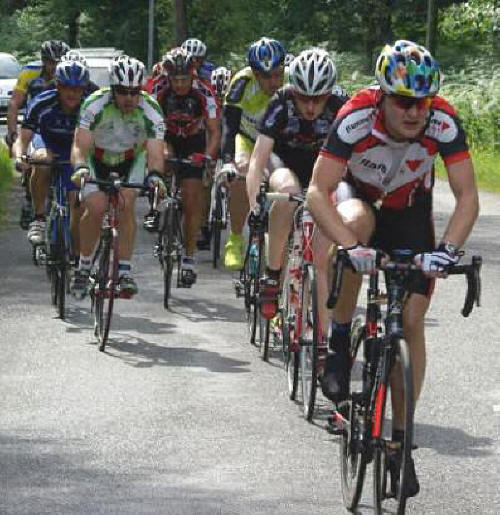
It's far better to be dishing out the pain than having it dished out to you!

Think
Before you start to think about what you want from next season you should,
as we said last month, ask yourself the following questions about your
previous season. Did I...
▼ race to my preseason expectations
▼ enjoy my season from beginning to end
▼ race with my peers on an equal footing
▼ balance training & racing with the needs of real life
Goal Setting
Use the questions above to
reflect on last season's achievements and to set and adjust your goals for the
forthcoming year. But before you plan any goals for next season
please read the rest of this page,
Goals need to conform to a simple protocol in order to aid and secure successful accomplishment. All goals need to follow the SMARTER principle.
Goals should be:
▼ Specific; what exactly are you going to do
▼ Measurable; how will you know you've achieved it
▼ Achievable; is it within your physical attributes
▼ Realistic; do all the other parameters stack up
▼ Timescaled; by when are you going to achieve it
▼ Enforceable; be accountable to someone
▼ Recorded; write it down so you can see it every day
Consider the following two statements.
Next year, I'm going to do
well and win a 25mile time trial.
I'm going to plan my training to ensure I can go under the
hour in September's Local 25 TT Championship.
If I do I'll buy a new helmet
if not I'll ride
the next evening ten in a thong
Statement one is a laudable aim but a goal? Who defines "well"? It's specific, I'll give you that, but by when will it be accomplished? If you're currently banging out 1:09, 25's, how realistic is it?
Also, many things are out of your control. Even if you say you're going to win and train to your absolute physical limits, if Bradley Wiggins turns up (which actually happened to one of our riders on one of their objective rides!) and goes faster, you've failed due to factors totally out of your control! Don't set yourself up to fail.
Statement two says exactly what you're going to do. When you're going to do it. And what reward you'll enjoy when you've achieved it.
If you go under the hour and don't win, you've still achieved your objective. If there isn't a penalty for failure or a reward for success, where's your extrinsic motivator? You need to have a little external pressure; even if it is self-inflicted.
Also you may have the physical attributes to reach your goal but if you've not ridden for two months and want to win next week; how realistic is that? Keep things in proportion.
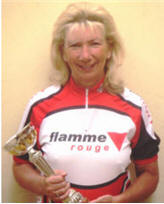
If you set finishing the Etape with a gold standard ride as your goal, and you only have five hours a week in which to train, then it could be a tall order.
So set your SMARTER goals to match your available training time, physical attributes, and available resources.
Whatever you decide, write it down, bounce it off someone else as a sanity check and stick it where you can see it every time you get on your bike.
Make it your reason for training, your reason for living and your reason for putting yourself through the pain of banging out the 60 second killers.
If you do, you could very well end up with a nice trophy at the end of the year!
There's also an excellent resource (even though I say so myself) by clicking the Think for Victory link or checking out the Think Like a Pro factsheets from the menu list.
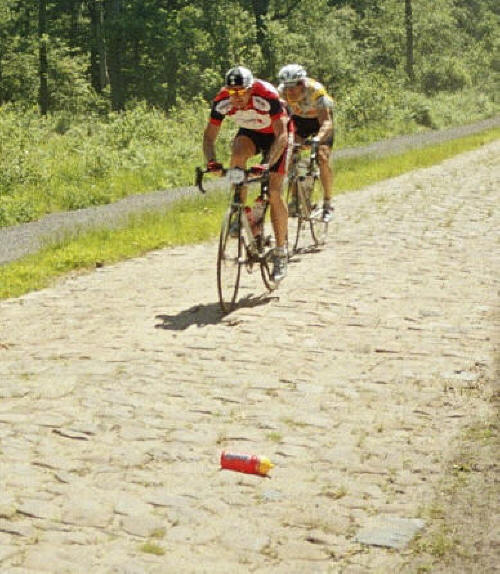
Tranche d'Arenberg ~ full gas, hold on to your bidons...
Motivators
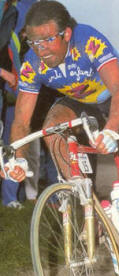 When preparing for
the Paris-Roubaix sportive, (above) I placed a poster of Gilbert Duclos Lasalle riding
the Hell of the North, right bang in front of my
turbo.
When preparing for
the Paris-Roubaix sportive, (above) I placed a poster of Gilbert Duclos Lasalle riding
the Hell of the North, right bang in front of my
turbo.
For a whole year, he was pinned up right in my eye line. Every time I got on my turbo to do another hideous set of leg snapping intervals, he was staring back at me.
Whenever I thought I was shot, I always found the inspiration to try just one more. You can't imagine how much it helped a renowned slacker like myself.
I got that engrossed I even thought of fitting a pair of Rock Shox to my Colnago! Worked for Gilbert!
Find your own motivator and use it to inspire you towards your goal.
Plan to Train
Once you've defined where you
want to be, you need to understand where you are now and how you're going
to close the gap between the two. A SpiderGram
is a tool that can help you do this.
SpiderGrams can be designed to cover the attributes needed to compete at almost any level within our sport. Some attributes, depending on the discipline, are more important than others.
Sprinting is not really called for when riding Paris Roubaix; but muscular endurance is. Also bike handling skills aren't really called for when riding up Alpe D'Huez. But they are if you want to come down it quickly and safely.

First, define the attributes you need.
Secondly, rate where you need to be with a score of one to ten. Be realistic, not everything is, or can be, a full ten pointer.
Step three requires you to determine what you currently have by carrying out a self-analysis on your selected attributes. Be truthful about your strengths and weaknesses and don't be over-critical.
Score your current attributes out of ten and define the gap. Blue is where you need to be, red is where you now are,
Within five minutes you can actually see, laid out before you, the skills and attributes you need to address, over the winter, to make you a fitter, faster, stronger rider next season. If you want a copy of a Spidergram, just email me and I'll send you one.
Next month we'll cover how to build a plan to specifically target your training to close the gaps between now and your timescaled objective.
Train to a Plan
If you look at some of the other factsheets, listed
under the Physiological Menu above, you will
begin to see that cycling is all about oxygen storage, oxygen generation and
oxygen delivery. That's a lot of oxygen, which unsurprisingly, is
what you need to win races.
Winning races is about getting as much oxygen in to your lungs as possible (VO2max) and efficiently and effectively distributing it around your body and getting it to your muscles (Lactate Threshold & Anaerobic Capacity).
To do a 25 mile TT in an hour you need to knock out between 270 and 300 watts for the entire hour. For a 70 kilo rider this means you have to have a VO2max of around 57 ml/kg/min, or process nearly four litres of oxygen a minute.
Shifting oxygen from the air outside your body to the inside of your muscles is a complex operation. And to do it you need these little babies ~ mitochondria.
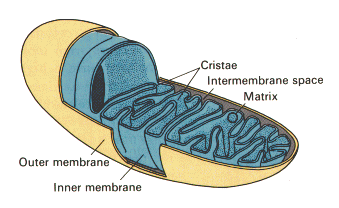
If you want to ride the hour you need loads of these little oxygen tanks, and the only way you can develop them is by using your winter training time effectively, or taking EPO. One has considerably less risk attached to it than the other.
To find out how much you need to improve, you need to know how much you have now. The only way of doing that is by taking a test, doing your structured training then re-testing at an appropriate point to measure the improvement and set the levels for the next training period. Don't leave these things to chance.
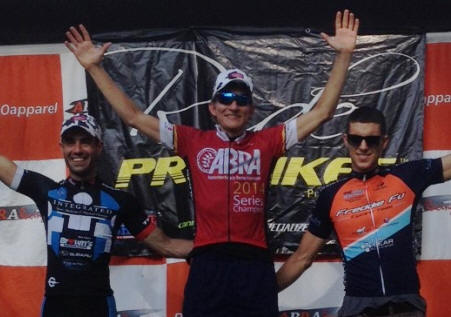
Some super-strong, aggressive riding, including a solo breakaway
from 25 miles out!, brought Integrated Sports Medicine, presented by
Browns Subaru rider, Eric Diamond
the Appalachian Bicycle Racing Association's 2014 Series
Championship.
An objective he'd planned the previous November...
The Message
November is the time to define objectives, or at least flay the
groundwork for the coming season.
November is when it all begins to kick off. It's the time we start intelligently eating, effectively training and actively resting; preparing ourselves for a faster new year.
Next season is still five months away but that doesn't mean we shouldn't start testing, preparing, and planning for it right now.
Sit down and think about what you would expect from next year. If it's to do the hour then you need to start thinking about how you can build your VO2max, cruise at 300 watts and consistently and comfortably ride at an average of 25 mph.
Progression, recovery and adaptation are the keys to your success so you need to build them into your plan. If you don't have one, or the time to prepare one, then here's some that may be of interest to you...
Once you have a plan stick to it and train according to the plan. We've seen it before, on much more than one occasion, where the plan called for an hour steady and the rider did three hours in the hills because they felt so strong. Two weeks later they've hit a block as they can't manage the planned power intervals due to tiredness.
Fight the temptation to follow the crowd. Believe in yourself, believe in your objectives, and if you've followed the criteria above, believe in your plan. Once you do, you're as good as there!
Until next time.








